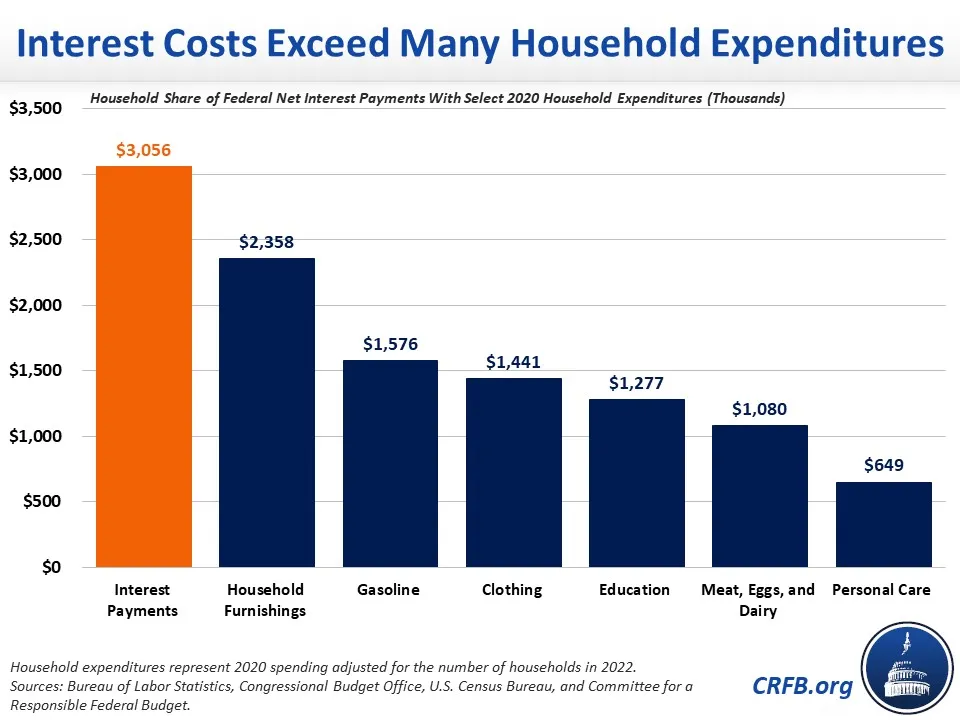Just How Big Are Federal Interest Payments?
According to the Congressional Budget Office's (CBO) latest baseline, the federal government will spend $400 billion on interest payments on the national debt this fiscal year (FY). That's equivalent to just over 8 percent of all federal revenue collections and roughly $3,055 per household. The federal government currently spends more on net interest than it does on Social Security Disability Insurance, food and nutrition services, housing, or transportation. At the same time, the household share of net interest is larger than average annual household spending on gasoline, home furnishings, clothing, or personal care.
Interest costs and the national debt could be even higher if interest rates continue their upward trajectory and outperform CBO's latest economic forecast. Each one percentage point increase in interest rates would increase FY 2022 interest spending by $38 billion at today's debt levels.
Below, we put federal net interest payments in context. Much of this analysis is updated from our March 2021 analysis, "How High Are Federal Interest Payments?"
How Much Does the Federal Government Spend on Net Interest?
The roughly $400 billion the federal government is projected to spend on net interest payments in FY 2022 is more than it is expected to spend on veterans' programs ($269 billion); food and nutrition services ($230 billion), including the Supplemental Nutrition Assistance Program; Social Security Disability Insurance ($142 billion); federal civilian and military retirement ($133 billion); transportation ($130 billion); elementary, secondary, and vocational education ($129 billion); housing ($78 billion); higher education ($69 billion); Supplemental Security Income ($61 billion); and science, space and technology ($37 billion).

Looking further, by FY 2032, interest costs ($1.2 trillion) are projected to be larger than federal spending on Medicaid ($789 billion) and defense ($998 billion), and only 5 percent smaller than total nondefense discretionary spending.
Interest Costs Comprise a Large Share of Household Income
The roughly $400 billion the federal government is projected to spend on net interest payments in FY 2022 is equivalent to roughly $3,055 per household. That's more than the typical household spends annually on major household expenditures, including home furnishings, gasoline, clothing, education, or personal care. Net interest payments effectively consume all corporate income tax revenue or over one-quarter of all payroll tax revenue, and they are nearly five times as large as federal receipts from excise taxes or customs duties.

Higher Interest Rates Would Increase Interest Costs
The average interest rate on ten-year Treasury notes is currently around 3.0 percent, which is roughly 40 basis points (0.4 percentage points) higher than the 2.6 percent CBO projected it would be this quarter. If interest rates continue to outperform CBO's latest economic forecast, the result will be more debt and more spending needed to service that debt. For example, if interest rates were 100 basis points (one full percentage point) higher than projected for 2022, interest costs would total $437 billion in FY 2022. If interest rates are 200 basis points (two percentage points) above CBO's forecast, interest costs would total $475 billion this year. On a per-household basis, a one or two percentage point increase in interest rates would increase costs to $3,345 and $3,635 respectively. For more on the impact of higher interest rates on interest costs and the national debt, see our recent analysis "What Would Higher Interest Rates Mean for the Debt?"
*****
Interest payments on the national debt are currently the sixth largest line item in the federal budget. As the national debt continues to rise and interest rates continue their upward trajectory, net interest will consume a larger and larger share of federal spending and ultimately become the largest federal government line item by mid-century. To reduce the size of the debt, and in turn interest payments on that debt, policymakers should pursue a combination of entitlement reforms, spending reductions, and revenue increases.


